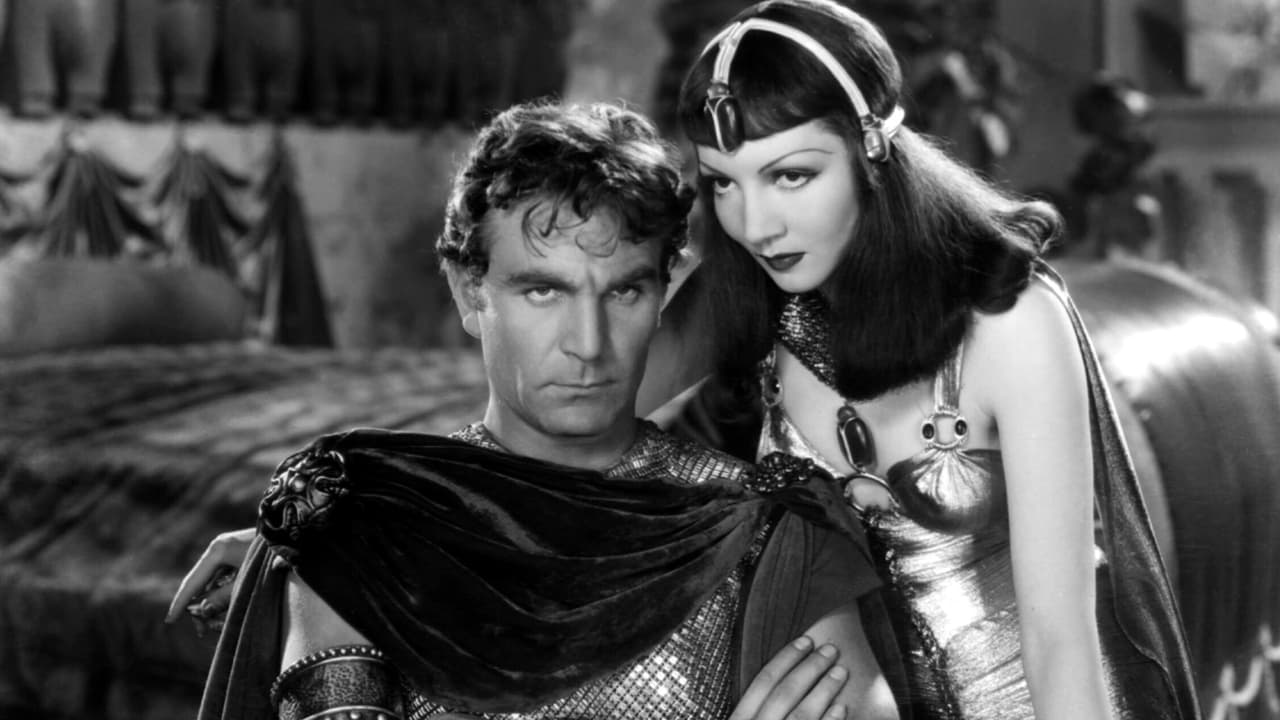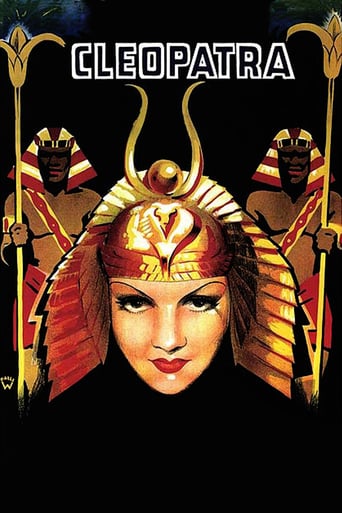

Overrated
... View MoreToo much about the plot just didn't add up, the writing was bad, some of the scenes were cringey and awkward,
... View MoreI really wanted to like this movie. I feel terribly cynical trashing it, and that's why I'm giving it a middling 5. Actually, I'm giving it a 5 because there were some superb performances.
... View MoreIt's an amazing and heartbreaking story.
... View MoreI caught this on Turner Classic a couple of weeks ago, and went into it not really knowing much at all about the story of Cleopatra. I know I had to read Shakespeare's "Julius Caesar" in high school, but I never really got into the more romantic side of the story of Cleopatra, Julius Caesar and Mark Antony. I've also never seen the Elizabeth Taylor version of the film that comes thirty years or so after this movie, so I went into it quite blind.I found the 1934 version of "Cleopatra" to be a real treat. The film tells a dramatic tale that is quite encompassing. The acting was good and the story quite developed. One of the best parts of the movie is the detailed and grandiose sets throughout the movie--all of which are quite ornate and extraordinary even by today's standards, let alone by 1934's. At the end of it all I found myself enlightened to a bit of world history that I did not know before the movie, and entertained throughout. The only reason I didn't rate the film higher is that despite it's being so well done, I can't really say that it stands out as a favorite or something I'd want to watch over and over again. Still, it's quite good for what it is, and certainly worthy of seven stars.
... View MoreTime is not always kind to movies, and Cecil B DeMille's 1934 version of Cleopatra is certainly a case in point. Although interesting for its risqué imagery and impressive set pieces, the film holds up less well in terms of performance and plot. It's easy enough to get hold of a really crisp print of the film on DVD, but this can't disguise the fact that it offers little to entice modern viewers beyond an element of curiosity value.Julius Caesar (Warren William) arrives in Egypt intent on adding it to his long list of conquered kingdoms. He is quickly beguiled by the Egyptian queen Cleopatra (Claudette Colbert), who promises him the riches of her great nation, plus India too, if he agrees to spare Egypt from the wrath of Rome. Later, Cleopatra foils an assassination attempt on herself and Caesar, further gaining the admiration of the Roman leader in doing so. Back in Rome, the senators are concerned that Caesar plans to abolish their Republic and install himself and Cleopatra as emperor and empress. Unhappy at this idea, they assassinate him on the Senate steps, leaving two of his most trusted subordinates, Octavian (Ian Keith) and Marc Anthony (Henry Wilcoxon), to take joint control of the Roman Republic. Marc Anthony vows to capture Cleopatra and bring her back to Rome in chains, after which he intends to lead a total invasion of Egypt. However, once he meets the alluring and beautiful Egyptian queen, he quickly falls in love with her. This in turn invites the full fury of Rome upon him, and gives Octavian all the excuse he needs to curse him and declare war against him. Abandoned by his old allies, and doomed to destruction for the sake of his love for one woman, Marc Anthony has no choice but to face his tragic fate alongside Cleopatra.DeMille's film has moments of interest for movie buffs and film historians, but the wooden performances and several tediously unspooled scenes restrict its wider appeal. Colbert utterly owns the movie as the title character, floating elegantly across the sumptuous art deco sets in an array of revealing outfits. Alas, she is not helped much by the supporting players, many of whom chew the scenery most unconvincingly. Wilcoxon as Marc Anthony is especially guilty of this, giving a performance that's slightly more wooden than Cleopatra's barge. The dialogue is generally pretty terrible, a mismatched muddle of jarringly modern talk delivered in English and American accents. It hardly fits the 'feel' the film seems to be going for, and by the end becomes something of an annoyance. That's not to say there aren't occasional highlights along the way. The film's most famous sequence, which involves Cleopatra's seduction of Marc Anthony aboard her barge, lives up to its reputation, while the sequence detailing the assassination of Caesar is handled effectively in a nicely underplayed way. All in all, the 1934 Cleopatra is unlikely to be picking up a whole generation of new admirers any time soon - it's not just that the movie is old-fashioned, it's positively archaic. Having said that, it has sufficient points of interest to make it worthwhile for anyone interested in early sound cinema, or the vulgarly overblown film-making style of Cecil B. DeMille.
... View MoreA very stagy looking film with dazzling sets and costumes that were the trademark of the (in)famous Director. But this film seems unnecessarily studio bound and that is not typical C.B.Almost every scene is an exercise in opulent, overdone wonder that stuns the senses with hypnotic beauty and sound. All the indoor sets are impressive and sensuous.However, the battle scenes in the middle are pedestrian by the standards set in other, earlier films (some directed by DeMille), and are clumsily cut, and seem, unfortunately, unsatisfying and out of place. This is some lazy movie-making from a Director, that one doubts, has ever been accused of such.Cleopatra is alluring and sweet, beautiful and sexy, as are all the female extras semi-clad in sheer material and stepping sensuously throughout. The male leads are less than Shakespearean and are completely extinguished by the lavishness of it all and that's acceptable if one is looking for an example of a large number of pretty pre-code sex-pots and sensational choreography, but the dialog and story are nothing but sophomoric strings that loosely, and "barely" hold it all together.
... View More113: Cleopatra (1934) - released 10/5/1934, viewed 9/2/08.Russia and Afghanistan join the League of Nations. BIRTHS: Brian Epstein, Sophia Loren, Leonard Cohen, Brigitte Bardot.KEVIN: Cecil B. DeMille is at it again with this lavish sword-and-sandal quickie centering on the romantic life of the legendary Egyptian empress, this time played by Claudette Colbert. It should come as no surprise that this film is very poor history by any measure. Historical events that span decades are compressed into weeks or even days. Seemingly important benchmarks, such as the children that Cleopatra bore with Caesar and Antony, are dropped completely. I guess I was a little surprised at how shallow the movie came out to be. All of the actors are playing caricatures, and all their dialogue is spoken in overblown poetic prose. As this is the second DeMille movie we've seen, some comparing and contrasting is in order. 'Sign of the Cross' was more about the large setpieces than about the actual story. This film, no less lavish or expensive-looking, lets the background stay in the background more than hijacking the story. This time, all the big battles and sexytime bears the Production Code seal of approval. This film has far superior (and Oscar-winning) cinematography from Lubitsch-veteran Victor Milner. While 'Cleopatra' is paced and structured far better than 'Sign of the Cross,' I found the former movie, despite its many flaws and similarly two-dimensional performances, to be much more moving than this one. At no point during this film did I feel anything significant for the characters, except maybe for the first flirting scenes between Antony and Cleopatra, which were the best acted and best staged in the film. And Ian Keith is way too old for Octavian at any point in the story.DOUG: Cecil B. DeMille's take on Cleopatra, once probably the biggest and most definitive version of the story, now looks downright routine by comparison. I have not yet seen the 1964 version with Liz Taylor (I'm kind of waiting until they find all that missing footage). *Contract Player Alert*: Claudette Colbert (eventual Oscar winner for It Happened One Night), for all her awesomeness, never really disappears into the character; she just looks like Claudette Colbert in Cleopatra drag. Maybe it's just that she's the only face I recognized. Still, she looks very good in those costumes, and Cleo comes off (rather intentionally) as the most interesting character, with Caesar, Antony, and Octavian all come off as greedy one-dimensional fools. Also worth noting: the movie opens with a seal of approval from the Production Code of America, the first time we've seen it on the Odyssey so far. It's interesting to compare DeMille's Pre-Code spectacle Sign of the Cross with this one. It's especially noticeable in a montage sequence in the third act which shows the Roman army rampaging through Egypt. Demille's indulgent stretches of violence from Cross are gone, replaced with short, indecipherable clips with occasional stabbing and spearchucking. I hate to say it, but think I liked this one better than Cross. Unable to resort to racy scenes of violence and nudity, DeMille now has to focus on the story, what little of it there is. Recommended? Sure.Last film: The Count of Monte Cristo (1934). Next film: The Merry Widow (1934).
... View More